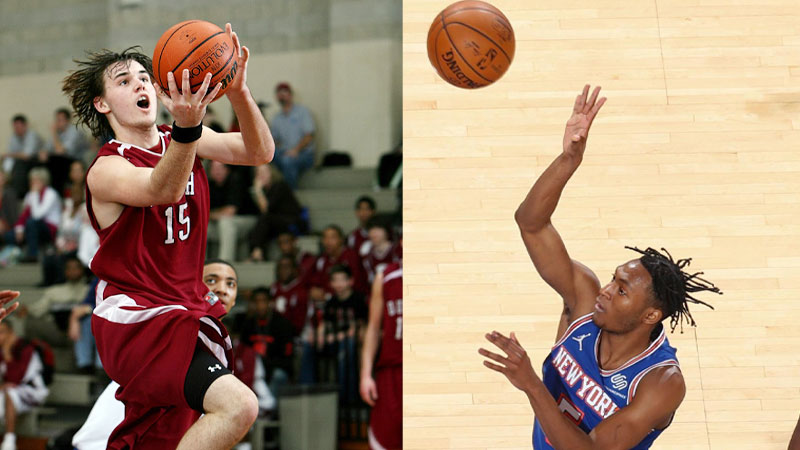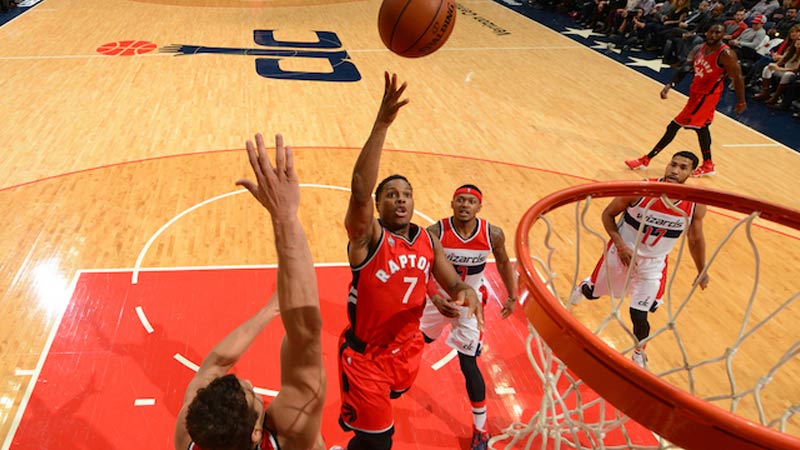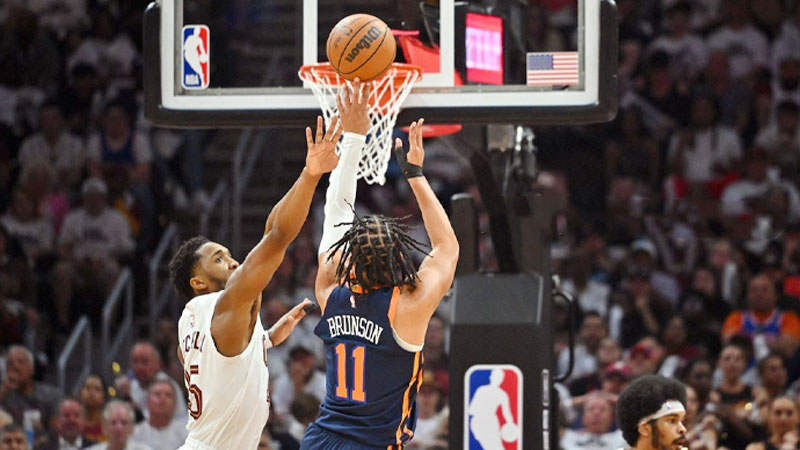Basketball is a sport that showcases a wide array of shooting techniques, each designed to help players score points efficiently. Among these techniques is the “floater,” a skillful and elegant shot that has become a significant part of many players’ offensive arsenals.
The floater offers a unique way to score over defenders positioned close to the basket, providing players with a mid-range option that is both effective and difficult to defend against. In this blog post, we will delve into the intricacies of the floater, its mechanics, and its significance in basketball.
Whether you’re a basketball enthusiast seeking to expand your knowledge of the game or a player looking to add another scoring weapon to your repertoire, join us as we explore the ins and outs of this essential shot in basketball.
What Is a Floater in Basketball?
In basketball, a “floater” refers to a type of shooting technique used by players to score over defenders who are positioned close to the basket.
It is a specialized shot that involves the player releasing the ball with a high, arcing trajectory, typically within the paint area, but before they get close enough for a layup.
The floater is a useful shot for players who are not tall enough or strong enough to consistently finish with layups or dunks when facing defenders near the rim.
It is also effective against shot-blockers or taller defenders, as the high release point of the shot makes it more challenging for them to block. To execute a floater, the player typically takes a short jump while dribbling toward the basket.
As they jump, they release the ball using their shooting hand with a soft touch, aiming for it to reach the peak of its trajectory just before it descends into the hoop. The goal is to make the shot before the defender can block it or contest it effectively.
What is the Difference Between a Layup and a Floater?

Source: topendsports.com
A layup and a floater are two different types of shots in basketball, each with distinct characteristics and purposes. Here are the main differences between a layup and a floater:
Shot Type and Mechanics
A layup is a type of shot taken very close to the basket, typically within a few feet. The player drives toward the hoop and releases the ball off the backboard or gently places it directly into the basket.
It is a high-percentage shot often used when a player is driving in for a fast break or when they’ve beaten their defender near the rim.
A floater, on the other hand, is a shot taken from a slightly farther distance compared to a layup but still closer to the basket than a typical jump shot. The player jumps off one foot while moving toward the basket and releases the ball with a high, arcing trajectory.
The ball softly drops into the hoop, typically over defenders who are close but not within blocking range. The floater is useful when driving to the basket and trying to avoid shot-blockers or taller defenders.
Release Point
A layup is released very close to the basket, often after a player has taken a couple of steps or dribbles from the free-throw line or below.
A floater is released slightly farther from the basket than a layup, usually just outside the paint area but not too far away to necessitate a jump shot.
Purpose and Application
Layups are used for high-percentage, close-range shots and are a fundamental part of a player’s scoring repertoire. They are often employed during fast breaks or when driving to the basket after beating a defender.
Floaters are employed when a player wants to score over defenders who are positioned close to the basket, but too far away for a comfortable layup. It’s an effective shot for players who are not tall or strong enough to finish with layups or dunks against taller opponents.
Defensive Considerations
Layups can be more susceptible to being blocked by taller defenders, especially if the offensive player doesn’t have a significant height or athleticism advantage.
Floaters are designed to be more difficult to block since they have a high release point, making them a good option when facing shot-blockers or taller defenders.
The main difference between a layup and a floater is the distance from the basket at which the shots are taken, the mechanics involved in each shot, and their specific applications in different game situations.
Both shots are valuable skills for players to have, as they provide options for scoring efficiently in various scenarios on the basketball court.
How to Do a Good Floater in Basketball?

Source: stack.com
Executing a good floater in basketball requires a combination of proper technique, timing, and practice. Here’s a step-by-step guide on how to do a good floater:
Footwork and Approach
- Start by dribbling the basketball toward the hoop from the perimeter or as part of a drive to the basket.
- Time your approach so that you’re not too far away from the hoop to attempt a floater, but also not too close that a layup or dunk would be more appropriate.
Body Positioning
- As you approach the basket, square your shoulders and hips toward the hoop.
- Keep your eyes on the target, which is usually the backboard or a specific spot on the rim.
Jumping Off One Foot
- To execute a floater, you’ll typically jump off one foot while moving toward the basket. This provides you with the necessary lift and balance for the shot.
- Practice jumping off the inside foot (the foot closer to the center of the court) for better balance and a smoother shooting motion.
High Release Point
- The key to a successful floater is the high release point. Release the ball at the peak of your jump, just before you start descending.
- Use your shooting hand to release the ball with a soft touch, providing the shot with the necessary arc to clear the defenders’ outstretched hands.
Wrist and Finger Action
Utilize your wrist and fingers to control the shot’s direction and touch. A gentle flick of the wrist with your fingertips imparts a backspin on the ball, helping it drop softly into the hoop.
Practice and Repetition
- Mastering the floater requires practice. Spend time shooting floaters from various angles and distances around the basket.
- Practice floaters off the dribble, as well as stationary shots, to simulate game situations.
- Work on both sides of the basket to be able to execute floaters from different angles during a game.
Game Application
- In a game, read the defense to determine when a floater is the right shot to take.
- Look for opportunities to use the floater when you’re driving toward the basket, and defenders are too close for a comfortable layup or dunk.
Stay Confident
Shooting floaters can be challenging but don’t get discouraged if you miss a few in the beginning. It’s a skill that improves with practice and experience.
Remember, like any basketball skill, mastering the floater takes time and effort. Incorporate it into your training routine and stay persistent. As you gain confidence and accuracy, the floater can become a valuable weapon in your offensive arsenal.
Challenges in Making a Floater
Making a floater in basketball can be challenging due to several factors. Here are some of the common challenges players face when attempting floaters:
Timing
Proper timing is crucial when shooting a floater. If released too early or too late during the jump, the shot’s trajectory and accuracy can be affected. Achieving the right timing requires practice and a good feel for the shot’s release point.
High-Arc Shot
Floaters require a high-arcing trajectory to avoid defenders’ outstretched hands and reduce the chance of getting blocked. Achieving the right arc while still maintaining accuracy can be difficult, especially in pressure situations during a game.
Soft Touch
A successful floater relies on a soft touch to allow the ball to gently drop into the hoop. Finding the right amount of force to apply on the shot without shooting it too hard or too soft can take time to master.
Balancing Body Movement
Shooting a floater involves jumping off one foot while moving toward the basket. Balancing the body’s movement, maintaining control during the jump, and coordinating the shooting motion can be challenging, especially when trying to avoid defenders.
Defensive Pressure
Floaters are often used to score over defenders positioned close to the basket. The presence of shot-blockers or taller defenders can make it more challenging to find a clear path to the hoop and execute the shot effectively.
Game Speed and Pressure
In a real game, players face time constraints and defensive pressure, which can impact shot accuracy. Practicing floaters under simulated game conditions can help players adapt to these challenges.
Consistency from Different Angles
Shooting floaters from various angles around the basket requires adjusting the shot’s release and arc. Achieving consistency from different positions on the court demands practice and muscle memory.
Physical Attributes
Players with different physical attributes might find it easier or more challenging to execute floaters. Smaller players might need to rely on floaters more frequently, but they might face more significant challenges when dealing with taller defenders.
Confidence and Decision Making
Players may lack confidence in their floater technique, leading them to opt for other shots or avoid floaters altogether, even when it’s a viable scoring option.
These challenges involve dedicated practice, mental preparation, and situational awareness during games. By consistently working on floaters and adapting to in-game situations, players can develop this valuable scoring tool and become more effective scorers in the paint.
Significance of FLoater in Basketball
The floater is a significant and valuable shot in basketball for several reasons:
Scoring Over Defenders
The floater allows players to score over defenders who are positioned close to the basket but too far away for a comfortable layup or dunk. This shot is especially useful when facing shot-blockers or taller opponents, as the high release point makes it more challenging to block.
Mid-Range Option
Floaters provide players with a mid-range scoring option. While layups and three-pointers often receive more attention, floaters are effective in the intermediate area between the paint and the three-point line, giving players an additional weapon to attack the defense.
Versatility for Guards
Floaters are particularly valuable for guards and smaller players who might struggle to finish at the rim against larger defenders. Having a reliable floater in their arsenal enables guards to score efficiently and avoid getting blocked or disrupted inside.
Offensive Creativity
A floater allows offensive players to show creativity in their shot selection. By adding this shot to their repertoire, players become more unpredictable and challenging to defend, making it harder for opponents to anticipate their next move.
Counter to Defensive Strategies
Floaters can be an effective counter to defensive strategies like aggressive shot-blocking or protecting the paint. If defenders anticipate a player’s drive and collapse into the lane, the floater provides an opportunity to exploit the space left open just beyond their reach.
Pick-and-Roll and Drive Situations
In pick-and-roll situations or when driving to the basket, the floater is a useful option. If the screener’s defender shows hard or switches onto the ball-handler, the floater becomes an effective way to score before the big defender can fully contest the shot.
Game-Deciding Shots
In late-game situations, when there might not be enough time for a pass or when defenses are tightly packed, a well-executed floater can be the difference between winning and losing. Players with reliable floaters are more likely to make these crucial shots under pressure.
Offense in Transition
Floaters are particularly useful in transition offense when the defense is backpedaling to protect the rim. A player can use the floater to capitalize on the defense’s lack of positioning and score before they can fully set up their defense.
The floater is a versatile and effective scoring technique that provides players with an additional tool to attack the defense and score in challenging situations.
Its significance lies in its ability to offer an intermediate scoring option, outsmart shot-blockers, and provide guards and smaller players with a reliable way to score in the paint.
For any offensive player looking to expand their scoring abilities, developing a good floater can be a game-changing skill.
FAQs
What exactly is a floater in basketball?
A floater in basketball refers to a specialized shooting technique where the player releases the ball with a high, arcing trajectory while moving toward the basket. This shot is typically taken within the paint area but slightly farther from the hoop than a traditional layup.
The purpose of the floater is to score over defenders who are close but not within blocking range, making it particularly useful against shot-blockers or taller opponents.
How is a floater different from a layup?
While both the floater and the layup involve shooting near the basket, they differ in key aspects. A layup is a close-range shot taken directly at the rim, often off the backboard or with a gentle touch.
In contrast, a floater is released with a high, floating trajectory, usually just outside the paint area. It’s intended to score over defenders who are positioned close to the basket but too far away for a comfortable layup.
When should players use a floater in a game?
Players should employ a floater when driving to the basket and facing defenders who are positioned near the hoop. If layups or dunks are not viable options due to defensive pressure, shot-blockers, or congested paint, the floater becomes an effective scoring alternative.
It’s particularly valuable for guards and smaller players who may struggle to finish at the rim against taller opponents.
What are the key challenges in executing a good floater?
Mastering the floater requires overcoming several challenges. Players must develop proper timing, achieve a high-arc shot for evasion, and utilize a soft touch for a gentle landing into the hoop.
Additionally, balancing body movement, adjusting the shot from various angles, and gaining confidence in the technique are all significant challenges to overcome.
Which NBA players are known for their exceptional floaters?
Throughout NBA history, several players have become renowned for their exceptional floater skills. Tony Parker, the former San Antonio Spurs star, was a master of the floater, using it as a go-to scoring option during his illustrious career.
Stephen Curry of the Golden State Warriors is another player who has incorporated the floater into his offensive repertoire, making him an even more unpredictable and dangerous scorer.
Bottom Line
The floater is a remarkable and essential shot in basketball, offering players a versatile and effective way to score over defenders near the hoop. Its high-arc trajectory, soft touch, and ability to outsmart shot-blockers make it a valuable weapon, especially for guards and smaller players.
By understanding the mechanics and challenges of executing a good floater, players can add this impressive scoring technique to their skill set.
Just like the greats in the NBA who have utilized the floater to perfection, mastering this shot can elevate any player’s offensive game, making them a more potent force on the basketball court.
So, whether you’re a player seeking to enhance your scoring abilities or a basketball enthusiast looking to appreciate the artistry of the game, the floater is a shot that embodies both finesse and effectiveness in the world of basketball.







